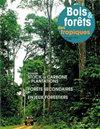大西洋杉木边材至心材内馏分丙酮提取物对4种子囊菌和黄网虫的驱避性能
IF 0.6
4区 农林科学
Q3 FORESTRY
引用次数: 1
摘要
大西洋杉是法国南部的一种树种,在气候变化的背景下,它可能成为未来几年的保护重点。这种树种在地中海盆地地区也具有相当大的生态和社会经济价值,主要以其耐用的木材和其精油的潜在有趣的化学特性而闻名。因此,尽管迄今为止进行的研究很少,但对其心材形成及其提取物特性的研究仍然令人感兴趣。本研究选取的阿特拉斯雪松树(树皮、边材、过渡材、外心材和内心材)的水/丙酮提取物在不同树高水平上的径向分布进行筛选。进行了高效液相色谱分析,特别是对这些提取部位的类黄酮化合物进行了表征。提取成分的径向变化突出了心材形成的现象。基于(-)-儿茶素、(+)-杉木素和黄酮类化合物的发生和径向演化,对杉木心材形成过程中涉及的代谢途径提出了假设。并对提取物的杀真菌和驱白蚁活性进行了测试。结果表明,大西洋杉水/丙酮提取物对白蚁有较强的驱虫活性,对作物和水果病原菌有中等的抗真菌活性。尽管这项研究的采样仅限于一棵树,但结果表明,阿特拉斯雪松提取物作为木材防腐剂和/或作为木本农业作物病原体的生物防治产品具有潜在的商业用途。将进行额外的测试和化学分析,以证实这些有趣的初步结果。本文章由计算机程序翻译,如有差异,请以英文原文为准。
Repellent properties against four Ascomycota species and Reticulitermes flavipes of acetonic extractives from Cedrus atlantica sapwood to inner heartwood fractions
Cedrus atlantica is a tree species present in the south of France which, in the context of climate change, could become a conservation priority in the coming years. This tree species is also of considerable ecological and socio-economic interest in the Mediterranean Basin area, where it is mainly recognized for its durable timber, and also for the potentially interesting chemical properties of its essential oil. Studies of its heartwood formation and the properties of its extractives are therefore of interest, although very few have been conducted so far.
The radial distribution of water/acetone extractives within the Atlas cedar tree (bark, sapwood, transition wood, outer heartwood and inner heartwood) selected for this study was screened at different tree height levels. High-performance liquid chromatography (HPLC) analyses were performed, especially to characterize flavonoid compounds in these extractive fractions. The radial variation of the extractive composition obtained highlights the phenomenon of heartwood formation. Assumptions were put forward as to the metabolic pathways involved in the heartwood formation process of cedar wood, based in particular on the occurrence and radial evolution of (-)-catechin, (+)-taxifolin and flavan compounds. The fungicidal and termite-repellent activities of the extracts were then tested. The water/acetone extractives from the Cedrus atlantica individual studied showed strong termite repellent activity and moderate antifungal activity against crop and fruit pathogens. Even though the sampling in this study was limited to a single tree, the results point to a potential for commercial use of Atlas cedar extractives as wood preservatives and/or as biocontrol products against pathogens of woody agricultural crops. Additional tests and chemical analyses will be carried out to confirm these interesting preliminary results.
求助全文
通过发布文献求助,成功后即可免费获取论文全文。
去求助
来源期刊

Bois et Forets Des Tropiques
FORESTRY-
CiteScore
1.50
自引率
16.70%
发文量
31
审稿时长
>12 weeks
期刊介绍:
In 1947, the former Tropical Forest Technical Centre (CTFT), now part of CIRAD, created the journal Bois et Forêts des Tropiques. Since then, it has disseminated knowledge and research results on forests in intertropical and Mediterranean regions to more than sixty countries. The articles, peer evaluated and reviewed, are short, synthetic and accessible to researchers, engineers, technicians, students and decision-makers. They present original, innovative research results, inventions or discoveries. The journal publishes in an international dimension. The topics covered are of general interest and are aimed at an informed international audience.
 求助内容:
求助内容: 应助结果提醒方式:
应助结果提醒方式:


